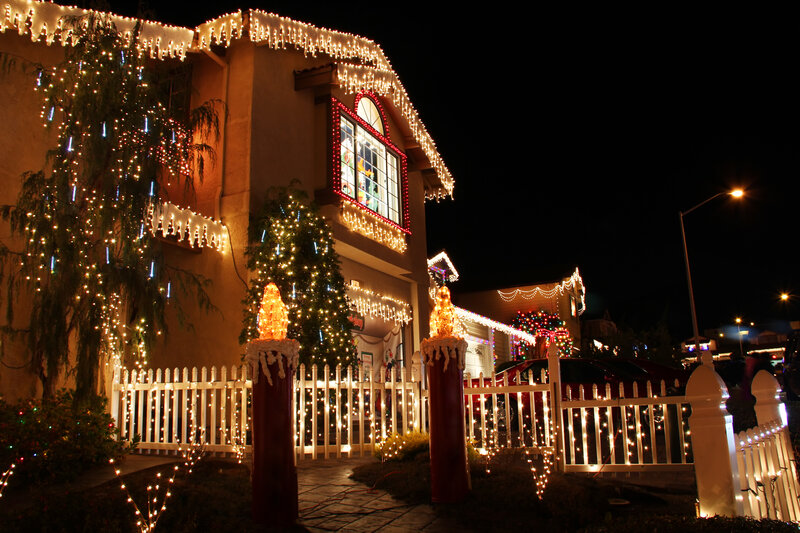-

Are you getting ready to put up your family’s annual holiday lights and decorations? Make sure that your excitement doesn’t get the best of you.
9 Safety Tips For Installing And Hanging Holiday Lights Outdoors
Before you climb a ladder or hang any light strands, take a deep breath and honor these 8 safety tips for outdoor holiday lights and other decorations.
Schedule a roof inspection beforehand
When’s the last time you had your roof professionally inspected? Most roof manufacturers and home insurance companies recommend inspecting your roof annually or biannually. Failure to do so may mean your roof isn’t insured or that roofing materials aren’t covered by the manufacturer’s warranty. More importantly, failure to have your roof inspected means you’re at risk of slipping or falling due to roof issues.
Roofing issues such as missing or damaged shingles and tiles, algae or moss growth, downed branches, and other debris put you at risk of slipping, falling, or other injuries. Roof inspections are affordable, and we’ll make sure your roof is safe before the winter storm (and holiday lights) seasons get started.
Clean the gutters and downspouts
Cleaning the gutters and downspouts is a seasonal roofing maintenance tip. We recommend doing it before the winter storm season and then performing a visual inspection after a heavy storm. All that accumulated debris in the gutters leads to water blockage and overflow.
Read 5 Important Gutter Maintenance Tips For the Winter to learn more about this important part of roof maintenance.
In addition to putting your roof at risk for leaks or other types of moisture damage, overflowing gutters pose an electrical hazard for the wires of light strands or other decorations that come in contact with electricity-conducting water. Therefore, never touch a wire or electrified decoration in wet conditions. Instead, wait until things dry out OR, in an emergency, cut power to external circuits before touching anything.
Inspect lights and decorations before installing or mounting them
Now that your roof is in ship shape and the gutters are free of debris, it’s time to inspect your outdoor holiday lights and decorations. First, examine them for any signs of damage, broken glass/plastic, sharp edges, or frayed/worn electrical cords.
After passing the initial anatomical inspection, plug them in on the ground to ensure they’re working. Any bulb replacement or repairs are best done on the ground rather than on the roof.
Use ladders as directed
Practice Ladder Safety 101 at all times. This includes things like:
- Never use a broken ladder.
- Use the 4 to 1 rule – the base of the ladder should be placed so that it is one foot away from the building for every four feet of height to where the ladder rests against the building.
- Make sure the ladder is firmly anchored on the ground. The area around the base should be uncluttered, and the ladder should be set on a solid, level surface. Stepladders should be fully opened.
- If you plan to get on the top of a roof, make sure you have the right ladder for the job. Roof ladders must extend above the edge at least three feet and be tied off at the top.
- Use a partner to hold the ladder steady whenever you’re on it.
- Always face forwards and use both hands when climbing a ladder.
- Wear secure shoes (no flip-flops, sandals, or mule-style shoes) with non-slip rubber soles.
If you don’t have the right ladder for the job OR you feel any fear or anxiety about using a ladder hanging holiday lights and decorations, contact a professional to help out.
Never walk on the roof
Unless you have the proper gear to tie yourself to the roof (harness, carabiner, tie-downs, etc.), you shouldn’t walk on the roof. Instead, crawl on all fours and make sure you are as low to the roof’s surface as you can be. Minimize the time you spend on the roof. This protects you – as well as your roof – from harm.
Never install outdoor decorations in wet conditions
Wait for a dry day to install electrical outdoor holiday lights and decorations. Wet conditions increase your chances of falls, injuries, or electric shock.
Use plastic safety clips
Forgo the urge to use nails or staples to hang outdoor holiday lights or decorations. These penetrations lead to water damage, leaks, or other moisture issues in the roof system or your home. Nails and staples may also damage your decorations’ wires and cords. Instead, use plastic clips designed for holiday decorations’ safe, penetration-free attachment. They’re affordable and available both online and in most hardware stores.
Install and use GFCI outlets for all outdoor decorations
Ensure all exterior electrical outlets are ground fault circuit interrupters (GFCIs). These outlets protect your home and occupants from electrical surges and cut the power if the plug/circuit is exposed to water to prevent electrocution.
Take care of the cords after hanging holiday lights
Once outdoor holiday lights and decorations are safely installed, take care of the cords. Make sure they moved out of the way, ideally tucked along the home’s exterior perimeter or walkways, so they don’t become trip hazards. Ideally, your electrical cords should never be walked on, driven on, or in the way of any lawn mowers or weed whackers.
The team here at Central Bay Roofing and Restoration wishes you and your family a joyous holiday season and new year. Do you need support inspecting or accessing your roof this winter? Contact us to schedule a consultation. (510) 521-7334.
Tips For Hanging Holiday Lights Safely
Call Us On (510) 521-7334
Your Local Roofers Since 1978
We invite you to contact us today for an estimate on your roofing project.
1814 Clement Avenue Alameda, CA 94501
(510) 521-7334
info@centralbayroofing.comLicense: 435272 Class B, C-39
Site powered by RooferBoost
Copyright 2017 Central Bay Roofing and Restoration | Login
